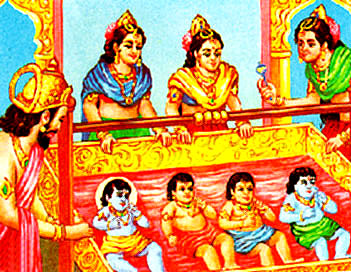
Flowers were falling from the sky, for the shining gods were happy. And happy also were the folk of the city of Oude, or Ayodhya. Banners waved. Wreaths were hung at every point. Women carried gold and silver dishes laden with gifts to the new-born son of the king. Players of musical instruments marched through the streets. None could tread without stepping on sweet musk and sandalwood and saffron that had been flung upon the ground.

King Dasaratha, in his joy, gave presents to the holy priests, the Brahmans—gifts Of gold and plate, and sacred cows. The people everywhere brought out rich jewels to adorn the walls of the houses, and the city was all ablaze with gold, silver, red rubies, green emeralds, blue sapphires, and gleaming pearls.For four weeks the sun forgot to set, and he beamed on the city where the four babes four sons of the king—were born.
One was the son of Queen Kausalya, namely, Rama the Delight; and he was dark. One was the son of Queen Kaikeyi, namely, Bharat; and he was also dark. The third and fourth were sons of the queen Samitra, namely, Lakshman and Satrughna; and both were fair. Now, Rama (Rah-ma) was the noblest. On the soles of his feet were the magic signs —the thunderbolt, the flag, and the goad which drivers use to urge elephants. Anklets tinkled on his ankles. A row of tiger’s claws were hung across his breast, and a necklace of gems with a charm fastened to it enriched his neck. Curls adorned his head. Clad in wee yellow drawers, the little Indian prince crawled and played, and his mother caught him up, and kissed him, and put him in the cradle, and took him out, and called him the darling of darlings.
But one day, as she and the babe were alone, she saw him change, and he grew, and he grew, and he grew until he seemed to fill the whole world; ay, and more than that; for not only were hills and woods and streams and seas all about his body, but even suns and moons and stars shone; and yet, in this vast sky and earth, she could still see her baby Rama. Thus for a while, he was so great that he could not be greater; and then he changed to the small child again. Such eyes have mothers; they see into the years to come, and say to themselves, ” My child will be noble.”
Rama could play and jest, and, while the king and the queen sat at the table, he would snatch up a handful of cream and curds and run away, thrusting the dainty into his mouth, and laughing. And all the royal court laughed. Rama could work. When he and his brethren were grown lads they became twice-born, and sacred threads were placed on each — the thread passing over one shoulder and lying on the breast. Then they went to the Guru, or teacher, to be taught in the book of hymns to the shining gods; and Rama learned the Vedas in a concise time — even all the four books of hymns.
The four brothers also took lessons in shooting arrows from the bow, and other lessons in something far better, namely, the right behaviour towards men, women and children. The manners of Prince Rama was so gentle and so courteous that all the city loved him, and the eyes of the folk followed him as he went along the highway.

